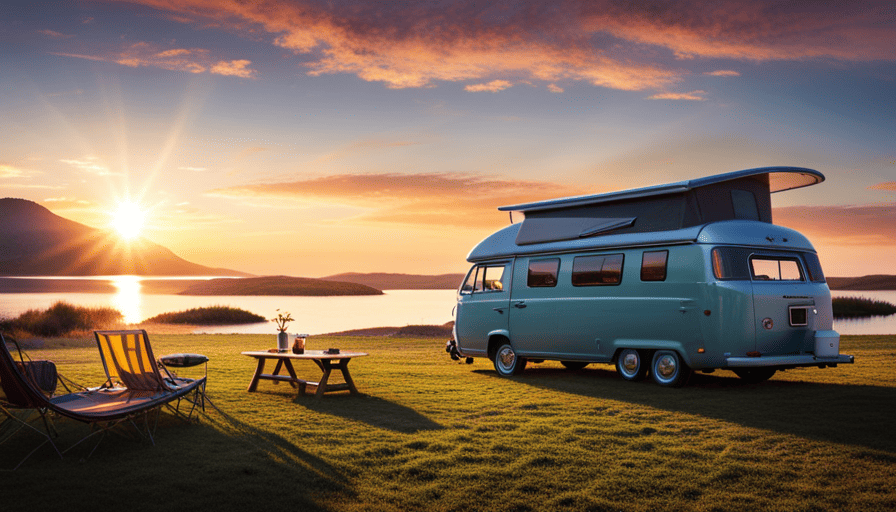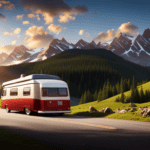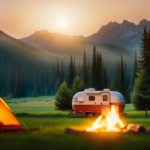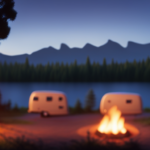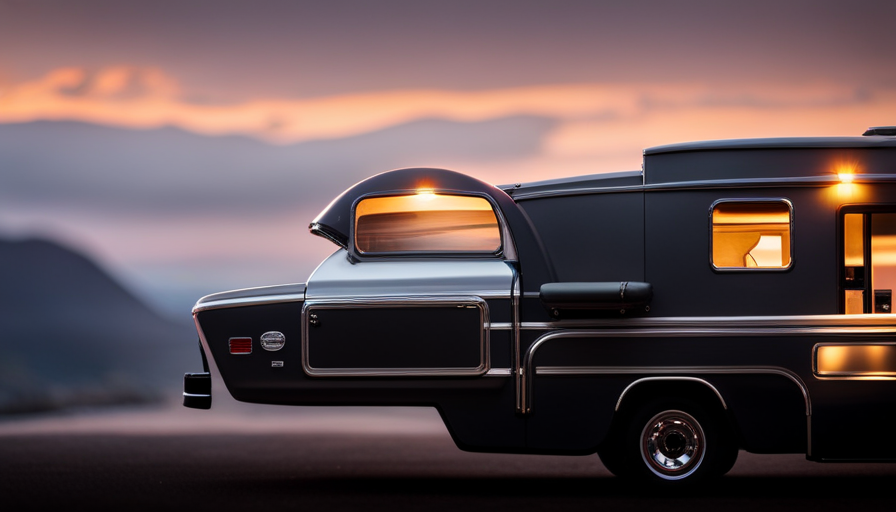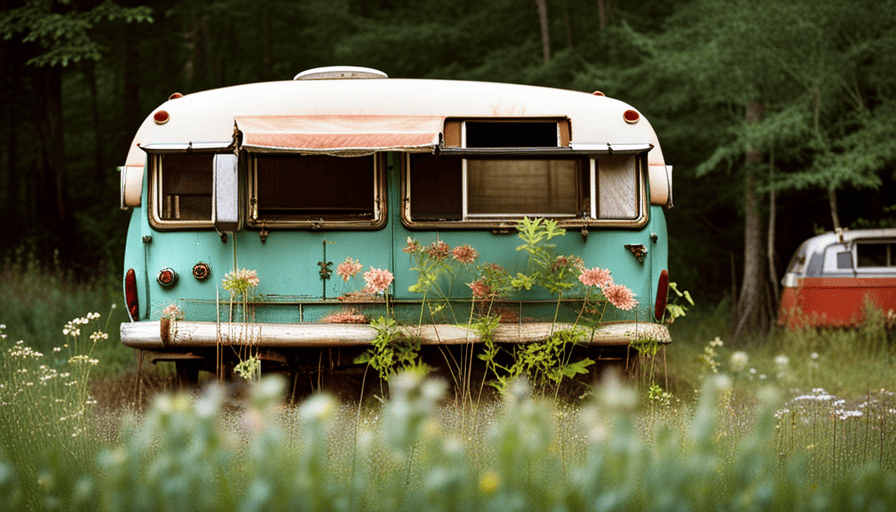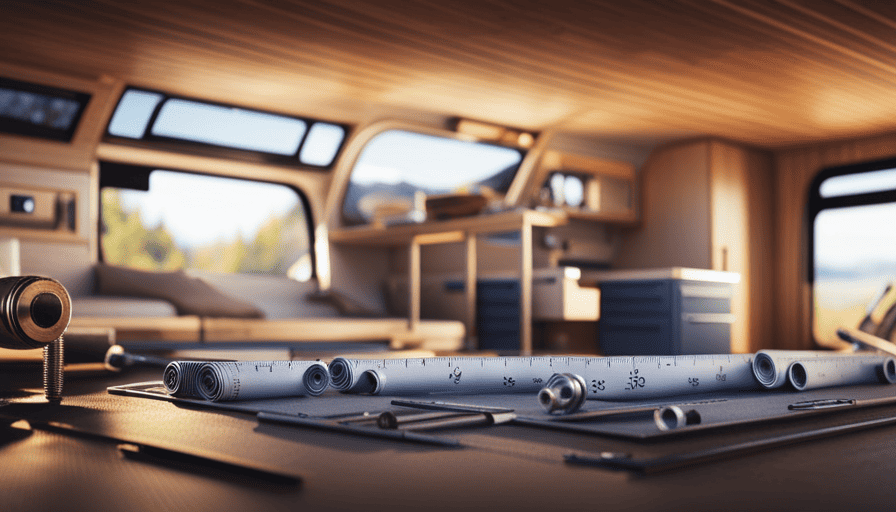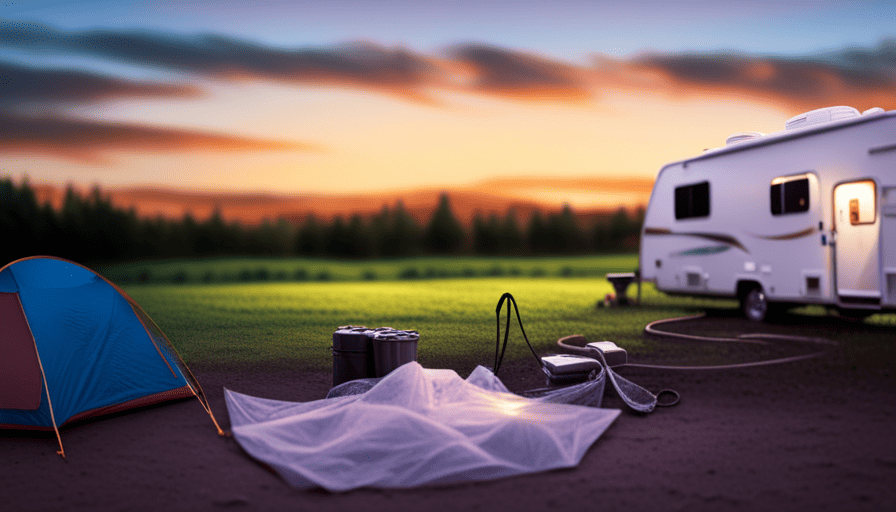Are you thinking about embarking on a road trip in a camper van? Let me clarify: it’s not as simple as it may seem at first. The allure of adventure and freedom is certainly enticing. However, before you hit the road on your exciting journey, there’s an important question that needs to be addressed: what is the financial cost of buying a camper van?
Now, don’t get me wrong, camper vans can be a fantastic investment. They provide a cozy home on wheels, allowing you to explore the world at your own pace. However, the price tag attached to these mobile abodes can vary greatly depending on a multitude of factors. From the type of camper van you choose to whether you opt for new or used, there are many considerations that will impact the final price.
In this article, we’ll delve into the various types of camper vans available, the factors that affect their prices, and even explore financing options.
So, if you’re ready to dive into the world of camper van ownership, buckle up and let’s explore the exciting possibilities that await you!
Key Takeaways
- The price of a camper van can vary depending on factors like type, age, and brand.
- Smaller camper vans start around $30,000, while larger motorhomes can cost over $100,000.
- Buying new offers the latest features, customization options, and warranty coverage, but at a higher cost.
- Buying used can save money upfront and may provide added features and upgrades, but reliability and maintenance concerns should be considered.
Types of Camper Vans Available
Looking to hit the road in style? Check out the awesome variety of camper vans available! When it comes to types of camper van conversions, the possibilities are endless. From compact and cozy vans to spacious and luxurious models, there is something to suit every traveler’s needs.
One popular type of camper van conversion is the Class B, which offers a compact and versatile layout. These vans are typically built on a standard van chassis and often include a small kitchenette, bathroom, and sleeping area. They’re perfect for solo travelers or couples who want a comfortable and maneuverable vehicle.
For those seeking more space and amenities, Class C camper vans are a great option. These vehicles are built on a larger chassis and often feature a separate bedroom, full kitchen, and bathroom. They provide a more residential feel and are suitable for families or those who enjoy extended trips.
When it comes to the best camper van brands, some top contenders include Winnebago, Mercedes-Benz, and Airstream. These companies are known for their quality craftsmanship, innovative designs, and reliable vehicles.
Now that we’ve explored the types of camper vans available and the best brands, let’s delve into the factors affecting camper van prices.
Factors Affecting Camper Van Prices
One key factor that can impact the price of a camper van is the age of the vehicle. The older the van, the lower its resale value tends to be. However, there are several other factors that can affect the price of a camper van as well. To understand these factors better, let’s take a look at the following table:
| Factor | Description | Example |
|---|---|---|
| Age | The number of years since the van was manufactured. | 5 years |
| Condition | The overall state of the van, including its mechanical and cosmetic condition. | Good |
| Brand | The reputation and popularity of the camper van brand. | Mercedes-Benz |
Aside from these factors, other elements such as mileage, features, and demand for specific brands can also influence camper van prices. For instance, camper vans from popular brands like Volkswagen or Mercedes-Benz typically have higher resale values compared to lesser-known brands. Additionally, well-maintained camper vans with low mileage tend to command higher prices in the market.
Understanding these factors is crucial when considering whether to purchase a new or used camper van. Transitioning into the subsequent section about ‘new vs. used camper vans,’ it is important to weigh these factors to make an informed decision.
New vs. Used Camper Vans
When considering whether to buy a new or used camper van, there are several factors to consider.
The pros of buying new include getting the latest features and technologies, as well as the peace of mind that comes with a warranty.
On the other hand, buying used can save you money upfront and may allow you to get a higher-end model for a lower price. However, it’s important to consider the potential for repairs and maintenance costs.
When it comes to financing, it’s important to consider your budget and credit score, as well as the interest rates and terms offered by lenders.
Overall, the decision between buying new or used ultimately depends on your personal preferences, budget, and priorities.
Pros and Cons of Buying New
If you’re considering purchasing a camper van, you should weigh the advantages and disadvantages of buying a brand-new one. Here are four key points to consider:
-
Reliability: One of the biggest advantages of buying new is that you can expect a higher level of reliability. With a new camper van, you won’t have to worry about any hidden issues or wear and tear from previous owners.
-
Customization: Buying new gives you the opportunity to customize your camper van to your specific needs and preferences. You can choose the layout, features, and accessories that suit your lifestyle.
-
Warranty: New camper vans often come with a warranty, providing you with peace of mind in case anything goes wrong. This can save you money on potential repairs in the early years of ownership.
-
Higher Cost: The biggest disadvantage of buying new is the higher cost. New camper vans can be significantly more expensive than used ones, which may not be feasible for everyone’s budget.
Considering these factors, it’s important to weigh the advantages and disadvantages of buying new before exploring the pros and cons of buying used.
Pros and Cons of Buying Used
Considering the cost savings and the potential for hidden gems, buying a used camper van allows you to experience the thrill of adventure without breaking the bank. However, there are pros and cons to consider before making a purchase. On the positive side, buying used can save you a significant amount of money compared to buying new. Additionally, used campers often come with added features and upgrades that the previous owner has already invested in, giving you more value for your money. On the other hand, the reliability and maintenance of a used camper van may be a concern. Older models may require more frequent repairs and may have a higher risk of breakdowns. It is important to thoroughly inspect a used camper before buying to ensure it is in good condition. Transitioning into the next section about considerations for financing, it is important to assess your budget and explore financing options that work best for you.
Considerations for Financing
To make your dream of owning an adventure-ready home on wheels a reality, carefully evaluate your financial options for purchasing a used camper and unleash the freedom to explore the world.
When considering financing options for a camper van, it’s important to take into account factors such as interest rates, loan terms, and credit score requirements. Different lenders may have varying requirements, so it’s essential to check your credit score beforehand and understand how it may impact your ability to secure a loan. A higher credit score can often lead to better loan terms and lower interest rates.
By exploring different financing options and understanding your credit score requirements, you can make an informed decision that suits your financial situation. Transitioning into the subsequent section about the average price range for camper vans, it’s crucial to have this financial information in mind as you continue your search.
Average Price Range for Camper Vans
The average price range for camper vans varies depending on factors such as size, age, and amenities. When considering the cost of a camper van, it’s important to take into account the factors that can affect its depreciation. Factors such as the brand, model, and condition of the camper van can all impact its resale value over time.
Additionally, hidden costs of ownership, such as maintenance and insurance, should be considered when determining the overall cost of owning a camper van.
Camper vans come in a variety of sizes, ranging from compact vans to larger motorhomes. Smaller camper vans tend to be more affordable, with prices starting around $30,000. On the other hand, larger motorhomes with more amenities can cost upwards of $100,000 or more.
Age is another important factor to consider, as older camper vans may have a lower price tag but could require more maintenance and repairs.
When it comes to amenities, camper vans can range from basic to luxurious. The more amenities a camper van has, such as a kitchen, bathroom, and sleeping accommodations, the higher the price will be. It’s important to carefully consider the amenities that are necessary for your needs to avoid paying for features you won’t use.
The average price range for camper vans can vary significantly depending on factors such as size, age, and amenities. When considering the cost of a camper van, it’s important to take into account the factors that can affect its depreciation and the hidden costs of ownership.
Moving on to additional costs to consider, there are other expenses that should be factored in when budgeting for a camper van.
Additional Costs to Consider
When considering the cost of owning a camper van, there are several additional expenses that should be taken into account.
First and foremost, insurance and registration fees are essential. It’s important to factor in the cost of maintenance and repairs as well, as these vehicles require regular servicing.
Lastly, campground fees and fuel expenses can quickly add up, especially if you plan on traveling frequently.
Insurance and Registration
Purchasing insurance and registering a camper van can be a bit of a hassle, but it’s a necessary step to protect your investment. When it comes to insurance rates, they can vary depending on factors such as the make and model of your camper van, your driving history, and the coverage options you choose. It’s important to shop around and compare quotes from different insurance providers to ensure you’re getting the best rate.
Additionally, registration fees will also need to be considered. These fees vary by state and can range from a few hundred dollars to over a thousand dollars.
Once you’ve taken care of insurance and registration, you can move on to the next section about maintenance and repairs, which is an essential part of owning a camper van.
Maintenance and Repairs
Taking care of regular maintenance and addressing necessary repairs is crucial to ensure the longevity and reliability of your beloved home on wheels. When it comes to camper vans, maintenance costs can vary depending on the make and model. Basic maintenance tasks such as oil changes, tire rotations, and fluid checks are essential and should be done regularly. These routine tasks typically cost between $100-$200 per visit.
Additionally, it’s important to budget for common repairs that may arise, such as fixing electrical issues, replacing worn-out brakes, or repairing plumbing systems. These repairs can range from a few hundred dollars to several thousand, depending on the complexity of the problem. By staying on top of maintenance and promptly addressing repairs, you can minimize unexpected breakdowns and keep your camper van running smoothly.
Transitioning into the next section, campground fees and fuel expenses are also important factors to consider when calculating the overall cost of owning a camper van.
Campground Fees and Fuel Expenses
After discussing the costs of maintenance and repairs for a camper van, it’s important to consider other expenses that come with owning one. One significant cost is campground fees. Depending on the location and amenities offered, these fees can vary greatly.
Some campgrounds provide basic facilities like restrooms and showers, while others offer additional amenities such as laundry facilities, swimming pools, or Wi-Fi. It’s crucial to factor in these costs when budgeting for your camper van adventures.
Another expense to consider is fuel. Camper vans tend to have lower gas mileage compared to regular cars, so it’s essential to plan your trips accordingly and budget for fuel expenses. However, there are ways to save on fuel costs. For instance, maintaining a steady speed and avoiding rapid acceleration and braking can improve fuel efficiency. Additionally, researching and comparing fuel prices along your route can help you find the most affordable options.
Now, let’s move on to the next section, where we will explore some valuable tips for finding affordable camper vans.
Tips for Finding Affordable Camper Vans
When it comes to finding an affordable camper van, it’s important to shop around and compare prices. By doing so, you can ensure that you are getting the best deal possible.
Another tip is to consider buying from private sellers, as they may offer lower prices compared to dealerships.
Lastly, be on the lookout for off-season deals and discounts, as this can significantly reduce the cost of a camper van.
Shop Around and Compare Prices
To get the best deal on a camper van, it’s wise to shop around and compare prices, because as the saying goes, "Don’t put all your eggs in one basket." When searching for an affordable camper van, it’s important to have a clear idea of average market prices. This will give you a benchmark to work with when negotiating for a better deal. To help you visualize the range of prices, here’s a table that shows the average prices of different types of camper vans:
| Type of Camper Van | Average Price Range |
|---|---|
| Class B | $30,000 – $60,000 |
| Class C | $40,000 – $80,000 |
| Converted Van | $10,000 – $30,000 |
| Pop-Up Trailer | $5,000 – $15,000 |
| Teardrop Trailer | $3,000 – $10,000 |
By comparing prices from different sellers, you can ensure you’re getting the best value for your money. Once you’ve explored this option, consider buying from private sellers for potentially even better deals.
Consider Buying from Private Sellers
For the best bang for your buck, why not consider purchasing from private sellers? When buying a camper van from a private seller, there are several considerations for negotiation that can work in your favor.
Firstly, private sellers are often more motivated to sell and may be willing to negotiate on the price. Additionally, they may be more flexible when it comes to payment terms and financing options.
Another advantage of private sales is that you can often find camper vans that are well-maintained and in good condition, as many private sellers take pride in their vehicles.
However, it’s important to do thorough research and inspections before making a purchase to ensure you’re getting a fair deal.
With these considerations in mind, let’s now explore how to look for off-season deals and discounts.
Look for Off-Season Deals and Discounts
When considering buying from private sellers, it’s important to keep an eye out for off-season deals and discounts. This can be a great way to save money on your camper van purchase.
During the off-season, sellers may be more willing to negotiate prices in order to make a sale. Additionally, off-season travel destinations tend to have fewer buyers, creating a buyer’s market where you may have more bargaining power.
To make the most of off-season deals, here are three tips for negotiating prices:
-
Research recent sales prices to have a benchmark for negotiations.
-
Be prepared to walk away if the price doesn’t meet your expectations.
-
Offer to pay in cash to potentially secure a lower price.
By considering these tips, you can increase your chances of finding a great deal on a camper van.
As we move on to the next section, we’ll explore the financing options available for camper vans.
Financing Options for Camper Vans
While financing options for camper vans may vary, it’s worth mentioning that owning a camper van is like having a portable home on wheels, allowing you to explore the world without sacrificing comfort or convenience.
When it comes to camper van financing options, there are a few routes you can explore. One option is to secure a camper van loan from a financial institution. The loan requirements for a camper van may differ from traditional vehicle loans, so it’s important to research and understand the specific criteria. Some lenders may require a down payment, proof of income, or a good credit score.
Another financing option to consider is seeking out specialized camper van financing companies that cater specifically to the RV market. These companies often have a deep understanding of the unique needs of camper van owners and can offer tailored financing solutions.
Additionally, some manufacturers and dealerships may offer in-house financing options for camper vans. These options may come with specific terms and conditions, so it’s important to carefully review the terms before committing to a financing plan.
Transitioning into the subsequent section about ‘renting vs. buying a camper van,’ it’s also worth considering whether purchasing a camper van is the right choice for you or if renting might be a more suitable option.
Renting vs. Buying a Camper Van
When considering financing options for camper vans, it’s important to weigh the benefits of renting versus buying.
Renting a camper van can be a great option for those who want to experience the van life without the commitment of ownership. It allows you to test out different models and sizes, and you don’t have to worry about the maintenance and storage costs that come with owning a camper van.
One of the main advantages of renting a camper van is the flexibility it offers. You can choose the duration of your rental, whether it’s for a weekend getaway or a month-long road trip. Additionally, renting a camper van allows you to try out different destinations and travel routes, giving you the opportunity to explore new places without being tied down.
On the other hand, owning a camper van has its own set of advantages. It provides you with the freedom to travel whenever and wherever you want, without having to worry about availability or booking restrictions. Additionally, owning a camper van allows you to personalize and customize it to your liking, creating a home away from home.
Now that we’ve discussed the advantages of renting and owning a camper van, let’s move on to the next section and explore where to find camper vans for sale.
Where to Find Camper Vans for Sale
If you’re ready to embark on your own adventure and create lasting memories, you might be wondering where you can find the perfect camper van to call your own. Luckily, there are several options available to you.
One option is to visit RV dealerships in your area. These dealerships specialize in selling recreational vehicles, including camper vans. They often have a wide selection of new and used camper vans for sale, allowing you to find one that fits your needs and budget.
Additionally, you can also explore online classifieds, such as Craigslist or Facebook Marketplace, where individuals and dealerships alike advertise their camper vans for sale. These platforms provide a convenient way to browse through different options and compare prices.
It’s important to thoroughly research and inspect any camper van you’re interested in before making a purchase. Once you’ve found the perfect camper van, you’ll be one step closer to embarking on your next adventure.
In conclusion, finding a camper van for sale is made easy with the numerous options available, from visiting RV dealerships to searching online classifieds.
Conclusion and Final Thoughts
So, now that you know where to find your dream adventure mobile, it’s time to hit the road and start creating memories that will last a lifetime! Before embarking on your camper van journey, there are a few considerations for long-term ownership that you should keep in mind.
-
Budgeting for Camper Van Expenses:
- It’s important to set a realistic budget for your camper van expenses. This includes not only the initial purchase price but also ongoing costs such as insurance, maintenance, and fuel.
- Consider the cost of campground fees or overnight parking when planning your trips. Some campgrounds may have higher fees than others, so it’s good to factor this into your budget.
- Don’t forget to budget for any necessary upgrades or modifications you may want to make to your camper van to customize it to your needs and preferences.
-
Maintenance and Repairs:
- Regular maintenance is crucial to keep your camper van running smoothly. This includes oil changes, tire rotations, and other routine check-ups.
- It’s also important to be prepared for unexpected repairs. Consider setting aside a portion of your budget for any unforeseen repairs that may arise.
-
Resale Value:
- While you may be focused on the present, it’s also worth considering the future resale value of your camper van. Choosing a popular make and model, maintaining it well, and keeping records of maintenance can help increase the resale value when the time comes.
By keeping these considerations in mind and budgeting accordingly, you can enjoy your camper van to the fullest and create incredible memories on the open road. Happy travels!
Frequently Asked Questions
Are there any additional costs to consider when buying a camper van?
Yes, there are some additional costs to consider when buying a camper van. Apart from the initial purchase price, there may be hidden fees such as registration, taxes, and insurance.
Additionally, maintenance costs should be taken into account, including regular servicing, repairs, and potential upgrades or modifications. It’s important to factor in these expenses to ensure that you have a realistic budget for owning and maintaining a camper van.
What are some tips for finding affordable camper vans?
When it comes to finding affordable camper vans, there are a few key factors to consider. First, look for affordable camper van models that fit your needs and budget. Research various brands and models to find the best options for you.
Next, consider the best places to buy camper vans, such as online marketplaces, local dealerships, or auctions. By exploring these options and doing thorough research, you can increase your chances of finding a quality and affordable camper van that suits your needs.
What are the financing options available for purchasing a camper van?
When it comes to purchasing a camper van, there are various financing terms and loan options available. Financing terms can vary depending on the lender and your credit history.
Some common loan options include secured loans, where the camper van serves as collateral, and unsecured loans, which don’t require collateral but may have higher interest rates.
It’s important to research and compare different lenders to find the best financing option that suits your needs and budget.
Is it better to rent or buy a camper van?
Renting a camper van can be like having the freedom of the open road at your fingertips. The benefits of renting include the flexibility to try different models and destinations without long-term commitments.
On the other hand, long-term ownership provides the advantage of personalization and potential cost savings in the long run.
Ultimately, the decision between renting and buying depends on your specific needs and preferences.
Where can I find camper vans for sale?
You can find camper vans for sale at campervan dealerships or online camper van marketplaces. Campervan dealerships offer a range of options and allow you to physically view and test drive the vehicles before making a purchase.
Online camper van marketplaces provide a wider selection and often include both new and used vans. These platforms typically offer detailed listings with photos, descriptions, and pricing information to help you make an informed decision.
What Is the Price Range for Aliner Campers Compared to Camper Vans?
When it comes to the aliner camper price analysis, it is worth noting that Aliner campers generally fall within a lower price range compared to camper vans. While camper vans can range from $50,000 to $150,000 or even more, Aliner campers are generally more affordable, with prices starting around $10,000. However, it’s essential to consider factors like size, amenities, and customization options when determining the final cost of these recreational vehicles.
Conclusion
In conclusion, after exploring the various types of camper vans available and factors influencing their prices, it’s clear that owning a camper van requires careful consideration.
Additionally, it’s important to factor in additional costs and explore financing options. Whether to rent or buy a camper van depends on individual needs and preferences.
Lastly, there are numerous sources where one can find camper vans for sale. Ultimately, owning a camper van can provide an incredible travel experience, but it’s essential to thoroughly research and evaluate before making a decision.

